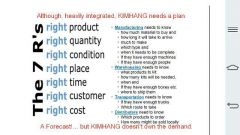![]()
![]()
![]()
Use LEFT and RIGHT arrow keys to navigate between flashcards;
Use UP and DOWN arrow keys to flip the card;
H to show hint;
A reads text to speech;
8 Cards in this Set
- Front
- Back
|
Integrated logistics |
Inbound part of a manufacturer’s logistics system interfaces with outbound side of supplier’s logistics system. Outbound part of manufacturer’s logistics system interfaces with inbound side of its customer’s logistics system. Their coordination is integrated logistics management. Goal is to increase efficiency and indirectly increase customer service. |
|
|
Total cost concept in the context of a supply chain |
Approach to managing systems where potential changes are evaluated on impact of change on total cost of the system. In other words, in evaluating costs of a specific logistics activity, people should take in to consideration of total cost instead of just cost of this activity only. |
|
|
Example of total cost concept |
For example, in evaluating transportation activity, people might be thinking about some different types of transporting goods such as air carrier, ocean carrier, motor carrier, etc. It is obviously that air carrier is the most expensive choice. However, if evaluating stops there, a big mistake can be made relating to the total costs concept. If a person choose ocean carrier because it is cheaper regardless other factors, he may get some tradeoffs such as high inventory holding costs, long lead time and decreased customer service level that might cause even greater total costs whereas if air carrier is chosen, because of the fast moving of goods, other logistics costs can be saved and the total cost may be much lower. |
|
|
Value chain concept |
Approach to evaluating overall performance of organization in terms of value contribution to profit margin of various primary and supporting areas in an organization. In the value chain, inbound and outbound logistics are important, primary components; that is, they contribute value to the firm’s customers and make company financially viable. The more integrated nature of marketing, sales, and manufacturing with logistics is also an important dimension of value chain. |
|
|
Example of value chain concept |

Ex: A diamond cutter can be used as an example of the difference. The cutting activity may have a low cost, but the activity adds much of the value to the end product, since a rough diamond is significantly less valuable than a cut diamond. Logistics: 7R (product, quantity, condition, place, time, customer, cost) |
|
|
Describe the three flows |
Integrated logistics management in the supply chain involve implementing a coordinated, two-way flows of goods/services, information and financials so that the SC function similar to one organization to satisfy the end-user. The top flow – products and related services : has been seen as an important focus in Logistics as customers expect their orders to be delivered in a timely, reliable, and damage-free manner. Transportation is critical to this outcome. Note that product flow is a two-way flow because of the reverse logistics systems for returning products to the supplier for a variety of reasons such as obsolete, damaged or worn out. The information flow : becomes an extremely important factor for success in SCM, also two-way flow. First flow is from the market back to the wholesalers, manufacturers and vendors about demand or sales data which help the replenishment and forecasting as well as the sharing of sales information on a ‘real-time’ basis which lead to less uncertainty about less safety stock among SC members. Second flow is information such as shipment notices, order status information, inventory availability from the manufacturers to the customers. The financial flow: has been viewed as one-directional/ one-way backward in the SC; e.g. payment for goods/ services and orders received. Today, customers receive orders faster, pay bills sooner and company collect cash sooner that affect their working capital. |
|
|
Explain why a supply chain is referred to as an extended enterprise |
Because : - - - - It crosses the boundaries of individual firms to span the related activities of all the companies involved in the total supply chain This extended enterprise should attempt to execute or implement a coordinated, two-way flow of goods/services, information, and financials. integration across the boundaries of several organizations in essence means that the supply chain needs to function similar to one organization in satisfying the ultimate consumer Supply chain management is defined using a pipeline analogy with the start of the pipeline representing the initial supplier and the end of the pipeline representing the ultimate customer. In other words, it was an extended set of enterprises from the supplier’s supplier to the customer’s customers. |
|
|
There are 5 principal types of economic utility that add value to a product or service. Name 4 of the 5 and pick 3 to discuss in more detail. |
These are form utility, place utility, time utility, quantity utility, possession utility.
Place utility- Logistics provides place utility by moving goods from production to where demand exists. Goods are in place where they can be consumed (right place), if not then they have no (or less) value. Logistics creates place utility through transportation. Place utility increase competition which usually lead to lower prices and increase product availability. Ex: adding customer value by locating products at the convenient place to them
Time utility means goods and service must be available when customers demand them. Logistics creates time utility through inventory maintenance, strategic location of goods and services, and transportation. Time utility emphases on reducing lead time and minimizing inventory levels through some logistics strategies such as JIT.
Quantity utility means delivering the right quantities of an item to where it is demanded. Logistics creates quantity utility through production forecasting, production scheduling, and inventory control. |

